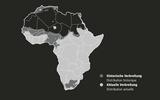
African leopard
Panthera pardus pardus
Ngo (Luganda)
Habitat
Semi-desert areas, savannahs, rainforests
Conservation status
Vulnerable. The species is at risk from habitat loss due to agriculture and development of settlements and transport, as well as hunting.
Biology
These big cats are highly adaptable, eating any prey they can catch, but preferring larger birds and mammals. Leopards also prowl in urban areas, preying on domestic animals such as dogs or sheep.

Diorama
1944–47
Females and males come together to mate but are otherwise solitary.
Provenance
9–11 September 1924, Ishasha river, Uganda, Bernard von Wattenwyl